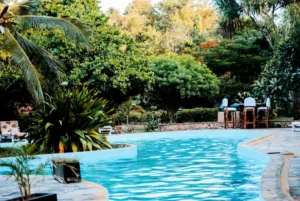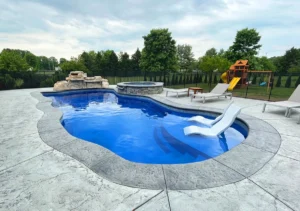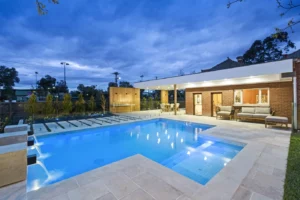An infinity pool is a luxurious addition to any home, offering a stunning visual experience where the water appears to spill over the edge, blending seamlessly with the horizon. The captivating design of an infinity pool makes it a desirable feature for homeowners looking to elevate the aesthetics and value of their properties. However, building one requires meticulous planning, precision, and expertise to ensure the pool’s functionality, beauty, and longevity. This article outlines the step-by-step process of infinity pool construction, helping you understand what goes into creating this dream feature and how to avoid costly mistakes.
The Complexity of Infinity Pool Construction
Infinity pools are far more complex to construct than traditional pools. Unlike regular pools, where water is contained within a single perimeter, infinity pools create an optical illusion of water extending to the horizon, making them visually striking. This design is achieved by constructing a special edge where water flows over and is recaptured below.
What Makes Infinity Pool Construction Challenging?
The construction of an infinity pool involves several key considerations that must be executed flawlessly. Here are some of the challenges you may face during the process:
- Complex Structural Design: The water overflow system is critical for achieving the “infinity” effect, requiring precise calculation of the pool’s shape, slope, and water level.
- Expensive Materials: Infinity pools often use higher-end materials like glass, tiles, and stone to complement their luxury appearance, which can increase construction costs.
- Site-specific Constraints: The terrain and location of your property play a crucial role in pool design. Steep slopes or uneven ground might complicate the construction process, requiring extra adjustments.
Common Mistakes in Infinity Pool Building
While building an infinity pool is a rewarding endeavor, it’s easy to make mistakes that can lead to significant setbacks or repairs down the road. Some common issues include:
- Incorrect Overflow Design: A poorly designed overflow system can cause uneven water flow or even flooding.
- Structural Support Issues: Failure to properly reinforce the pool’s structure can lead to cracks or leaks, compromising the pool’s integrity.
- Ignoring Site Conditions: Not considering the property’s slope or drainage issues can result in a difficult and costly build.
Why It’s Important to Get It Right?
Building an infinity pool isn’t just about creating a beautiful water feature—it’s also about ensuring it functions as intended and lasts for years. A poorly constructed infinity pool can lead to several issues:
Consequences of Poor Infinity Pool Design
- Water Flow Problems: If the water overflow system is not correctly installed, it can result in unsightly pools of water or uneven flow that disrupt the infinity effect.
- Leaks and Structural Failures: Incorrect foundation work or improper sealing can cause leaks, which might require expensive repairs and affect the pool’s performance.
- Increased Maintenance: When the pool is not constructed to high standards, it can lead to frequent maintenance issues, including problems with the filtration system and water circulation.
The Impact on Your Property Value
A well-designed infinity pool can significantly boost your property value. However, if your pool fails to meet design or safety standards, it could have the opposite effect. Buyers are unlikely to be impressed with a pool that looks great but is riddled with issues, such as cracks, leaks, or inefficient water flow systems. Ensuring a quality build guarantees both aesthetic appeal and functional excellence, contributing to long-term property value.
The Step-by-Step Process of Infinity Pool Construction
The process of constructing an infinity pool can be broken down into several phases. Each stage requires careful planning and expertise, but when executed properly, the result is an eye-catching, functional addition to your home.
Step 1: Design and Planning
The first step in infinity pool building is to work with an experienced designer who can translate your vision into a workable plan. During this phase, several important decisions will need to be made:
- Site Selection: Choose a location with the best vantage point for the infinity effect. This often involves positioning the pool on a slope to enhance the visual flow of water.
- Budgeting: Infinity pools come at a premium price, so it’s essential to determine your budget before starting. Consider costs for materials, equipment, labor, and any extra features you may want to include.
- Customization: You can personalize your infinity pool with features like waterfalls, LED lighting, or glass walls, which require thoughtful planning to ensure compatibility with the overall design.
Step 2: Site Preparation
Once the design is finalized, the construction team will begin preparing the site. This includes:
- Excavation: The area where the pool will be built needs to be excavated to the correct depth. For infinity pools, additional space may be needed for the catchment reservoir.
- Foundation Work: A solid foundation is crucial for the integrity of the pool. Structural reinforcements are necessary to support the weight of the pool and its water features.
Step 3: Structural Construction
With the site prepared, the actual pool construction begins. During this phase, the pool shell is built, and key structural elements are installed, including:
- Overflow System: The most important aspect of an infinity pool is the overflow system, which must be designed to direct water smoothly over the edge and into a catchment area below.
- Reinforced Materials: The pool shell is typically made from reinforced concrete to ensure durability and prevent cracking. Materials are chosen for their strength and waterproofing qualities.
Step 4: Installation of Pool Equipment
The next step involves installing all the essential equipment needed to maintain and operate the pool:
- Filtration System: Ensures the water remains clean and clear by removing debris and chemicals.
- Pumps and Heaters: These systems help circulate water, regulate temperature, and maintain water quality.
- Lighting: LED lighting can be installed for both aesthetic appeal and safety, adding a stunning glow to your infinity pool at night.
Step 5: Finishing Touches
The final touches make your infinity pool both functional and beautiful. This includes:
- Tiling and Coping: High-quality tiles and coping stones are installed around the edges of the pool to ensure a visually appealing and durable finish.
- Water Features: Optional features such as fountains or waterfalls can be added for added visual appeal.
- Landscaping: Completing the surrounding area with plants, walkways, and other landscaping elements enhances the overall beauty of your pool.
Step 6: Testing and Final Inspection
Before the pool is ready for use, it undergoes a series of tests to ensure everything functions as it should. This includes:
- Water Flow Testing: Ensuring the overflow system is working correctly and that water flows evenly.
- Equipment Check: Verifying that pumps, filtration systems, and heating systems are fully operational.
- Final Inspection: A professional inspector will check the pool to ensure it meets safety standards and complies with local regulations.
Conclusion
Infinity pool construction requires a combination of expert planning, precise execution, and attention to detail. Each step, from design to the final inspection, is crucial in creating a pool that not only looks stunning but functions properly and stands the test of time. By following this step-by-step process, you can avoid common pitfalls and ensure your infinity pool becomes a beautiful, lasting feature on your property.
Ready to bring your dream infinity pool to life? Contact AI Signature Pool Solutions for expert guidance and flawless construction.
FAQs
1. How long does it take to build an infinity pool?
The construction of an infinity pool typically takes between 3 to 6 months, depending on the complexity of the design and the site conditions.
2. How much does infinity pool construction cost?
The cost of building an infinity pool can range from $50,000 to $150,000 or more, depending on the size, materials used, and any additional features you choose.
3. Can an infinity pool be built on a sloped property?
Yes, infinity pools are often ideal for sloped properties, as the slope enhances the visual effect of the water flowing over the edge.
4. What is the maintenance required for an infinity pool?
Regular maintenance includes checking the filtration system, cleaning the pool, testing water chemistry, and ensuring the overflow system is functioning properly.
5. Can I add additional features like waterfalls or lighting to my infinity pool?
Yes, additional features such as waterfalls, LED lighting, and custom tiling can be added to enhance the aesthetics and functionality of your infinity pool.



